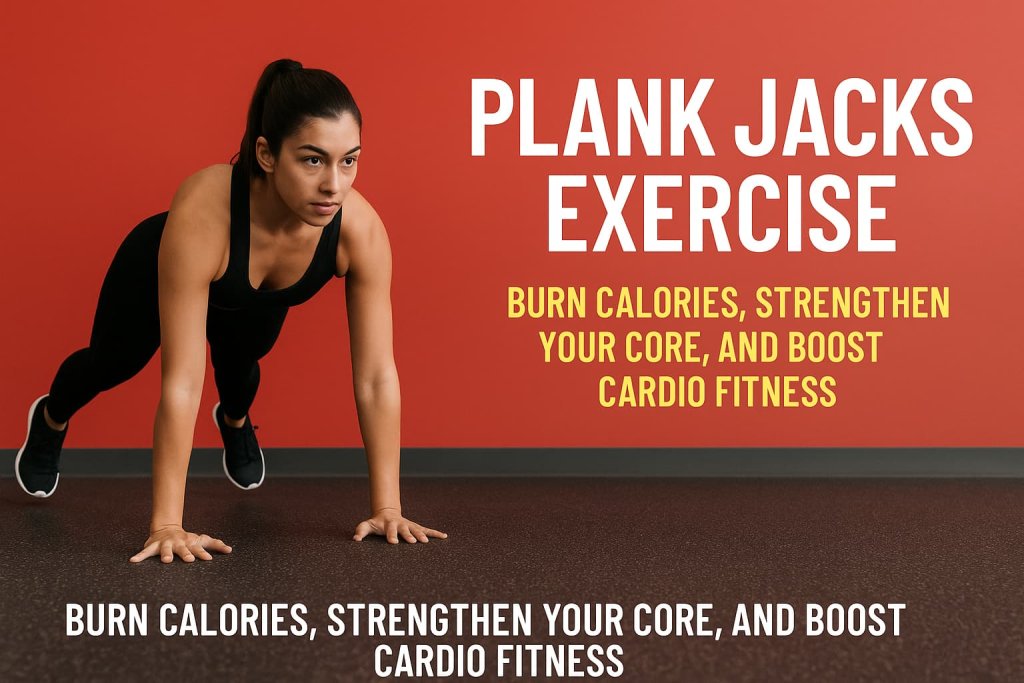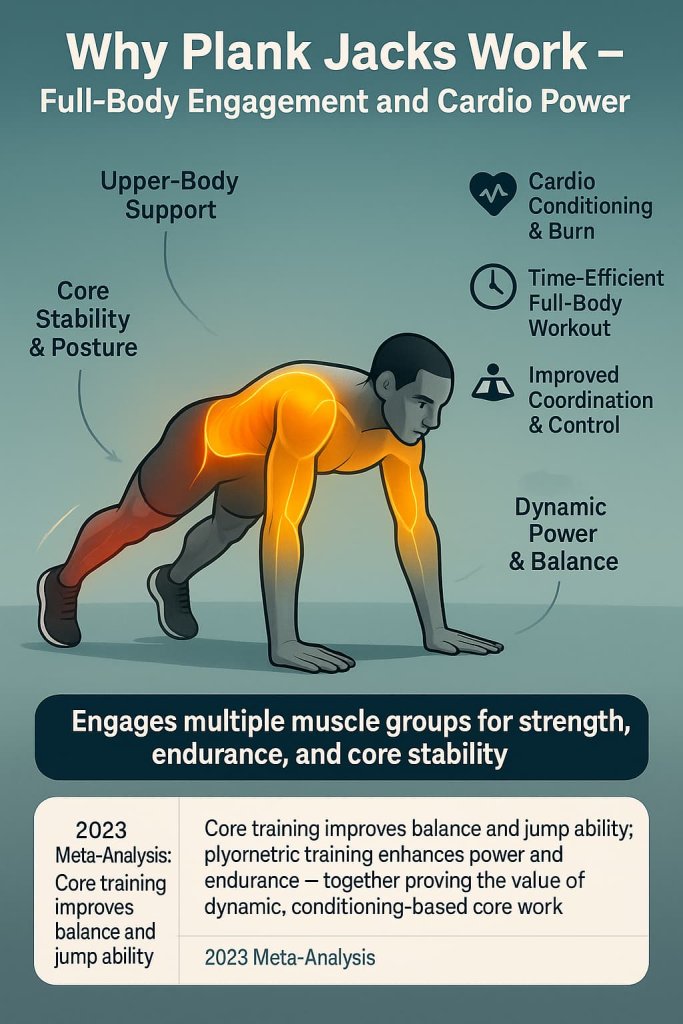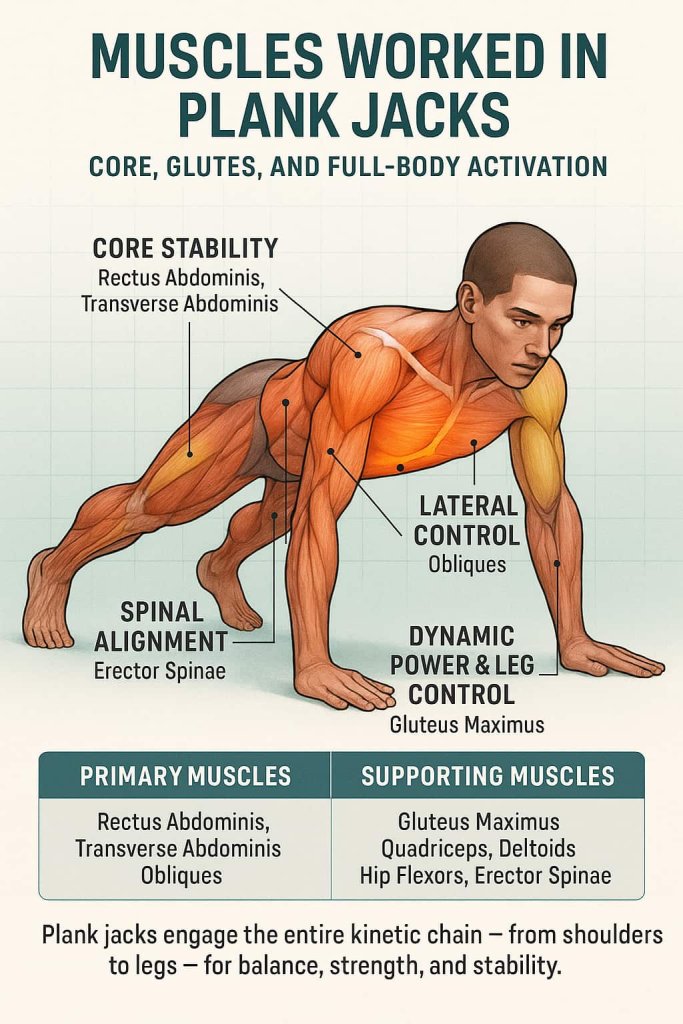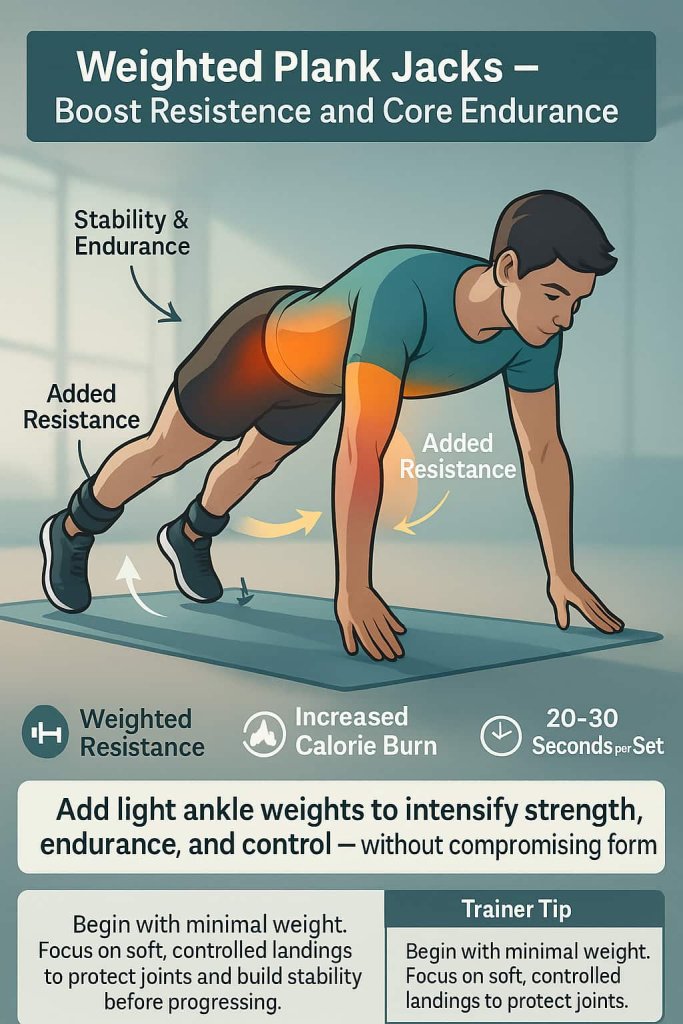The plank jacks exercise is a powerful core and cardio move that strengthens your abs, shoulders, and glutes while torching calories fast. It combines the stability of a plank with the intensity of jumping jacks, making it an efficient full-body conditioning drill.

Understanding how to perform plank jacks correctly helps improve stability, balance, and endurance without needing equipment. This dynamic plank variation can fit into any home, gym, or HIIT workout routine for fat loss, core definition, and improved cardiovascular fitness.
What Are Plank Jacks?
Plank jacks are a dynamic variation of the standard high plank, where you jump your feet in and out (like jumping jacks) while maintaining a tight core and straight body line. This simple change transforms a static core hold into a cardio-intensive, total-body movement.

You can perform them on the floor or a mat, and they require no equipment — just good body control and proper form.
Why Plank Jacks Work
Plank jacks work because they engage multiple muscle groups simultaneously while increasing heart rate.
Key benefits include:
- Core engagement: Constant stabilization through the abs and obliques protects your spine and improves posture.
- Cardiovascular conditioning: The jumping motion elevates heart rate, enhancing endurance and fat burning.

- Full-body activation: Shoulders, chest, glutes, and legs support stability, promoting coordination and balance.
- Time efficiency: One move blends strength, stability, and cardio, ideal for short, high-intensity workouts.
A 2023 meta-analysis found core training improves performance measures like balance and jump ability, and recent Frontiers papers show plyometric training enhances power and fitness—together supporting dynamic, conditioning-oriented core work over purely static holds.
How to Do Plank Jacks
Step-by-Step Guide:
- Start in a high plank — hands under shoulders, legs extended, body forming a straight line from head to heels.
- Engage your core — brace your abs and keep your hips level.
- Jump both feet outward, slightly wider than shoulder-width apart.
- Jump feet back together to the starting position, landing softly.
- Maintain steady breathing and repeat at a controlled rhythm for 30–60 seconds.
Trainer Tip:
- Keep hips low and aligned with your shoulders to avoid strain on the lower back.
- To reduce impact, step your feet out one at a time instead of jumping.
- For a harder variation, add shoulder taps or a push-up between jumps.
Muscles Worked in Plank Jacks
| Primary Muscles | Supporting Muscles |
|---|---|
| Rectus Abdominis (front abs) | Gluteus Medius & Maximus |
| Transverse Abdominis | Quadriceps |
| Obliques (internal/external) | Hip Flexors |
| Shoulders (Deltoids) | Lower Back (Erector Spinae) |

How they work:
- Core: Stabilizes the trunk and prevents lower-back sag.
- Shoulders: Support the upper body throughout the movement.
- Glutes & Quads: Control the jumping action and absorb impact.
- Obliques: Maintain lateral stability as the legs move outward.
Variations of Plank Jacks
1. Low-Impact Step Jacks
Why it works:
This beginner-friendly variation reduces joint impact while maintaining core engagement and shoulder stability. It’s perfect for those new to plank exercises or recovering from injury.
Muscles worked:
- Core (rectus abdominis, obliques)
- Shoulders (deltoids)
- Glutes and hip abductors
How to do it:
- Start in a high plank with hands under shoulders and core tight.
- Step one foot out to the side, then return it to the center.
- Repeat on the other side, alternating at a steady pace for 30–60 seconds.
Trainer Tip:
Keep your hips level and move slowly to prevent rotation. Focus on smooth, controlled steps rather than speed.
2. Forearm Plank Jacks
Why it works:
By lowering to your forearms, this version increases core isolation and decreases wrist strain, ideal for strengthening deep abdominal stabilizers.
Muscles worked:
- Transverse abdominis
- Obliques
- Glutes and hip abductors
- Shoulders and upper back
How to do it:
- Begin in a forearm plank with elbows under shoulders and body in a straight line.
- Jump both feet out and back together, keeping your torso stable.
- Perform controlled movements for 20–40 seconds.
Trainer Tip:
Avoid letting your hips drop — imagine pulling your belly button toward your spine throughout each jump.
3. Incline Plank Jacks
Why it works:
Using an elevated surface like a bench or step reduces shoulder and core loading, making it easier for beginners or those with wrist discomfort.
Muscles worked:
- Core and obliques
- Shoulders (front deltoids)
- Glutes and quads
How to do it:
- Place your hands on a stable elevated surface, feet extended behind you.
- Jump both feet out and back together while maintaining a straight body line.
- Keep movements light and rhythmic for 30–60 seconds.
Trainer Tip:
Engage your glutes to stabilize your hips. This variation is great as a warm-up or active recovery exercise between high-intensity sets.
4. Weighted Plank Jacks
Why it works:
Adding ankle weights increases resistance, enhancing muscular endurance and calorie burn while improving lower-body control.
Muscles worked:
- Core and lower back
- Glutes and quads
- Shoulders and triceps

How to do it:
- Strap on light ankle weights (1–3 lbs each).
- Assume a high plank and perform standard plank jacks with controlled jumps.
- Limit each set to 20–30 seconds to maintain form.
Trainer Tip:
Start with minimal weight and focus on controlled landings to protect joints. Increase load gradually as your endurance improves.
5. Push-Up to Jack Combo
Why it works:
This advanced combination integrates upper-body strength and cardio endurance, engaging nearly every muscle group.
Muscles worked:
- Chest (pectoralis major)
- Core and obliques
- Glutes and shoulders
- Triceps and quads
How to do it:
- Start in a high plank position.
- Perform one push-up, then immediately jump your feet out and back (plank jack).
- Continue alternating for 8–12 reps or 30 seconds.
Trainer Tip:
Keep your elbows tucked during the push-up and maintain tight core control during the jack. This move is ideal as a finisher for upper-body or HIIT workouts.
Common Mistakes to Avoid
- Sagging hips: Leads to lower-back strain — keep your core tight and spine neutral.
- Too fast pace: Rushing can break form; prioritize control over speed.
- Locked elbows: Maintain soft elbows to protect joints.
- Uneven breathing: Avoid holding your breath; exhale with every jump out.
Safety & Precautions
- Avoid if you have shoulder, wrist, or lower-back injuries.
- Always warm up for 5–10 minutes before performing (marching, arm circles, light cardio).
- Use a non-slip mat and ensure the surface is flat.
- Focus on form first, then increase intensity gradually.
How to Add Plank Jacks to Your Workout
- HIIT Circuit: 30 seconds plank jacks + 30 seconds rest × 3 rounds.
- Core Finisher: Add 2 sets after ab training.
- Cardio Booster: Use as an interval in bodyweight cardio sessions.
- Warm-Up: Include 2 light sets of 20 reps to activate core muscles before strength work.
FAQs
1. What are plank jacks good for?
They build core stability, cardiovascular fitness, and overall body strength in one move.
2. How many plank jacks should I do per day?
Start with 2–3 sets of 20–30 reps or 30–60 seconds, 3–4 times per week.
3. Do plank jacks burn belly fat?
They help burn calories and strengthen core muscles, which supports fat loss when combined with a healthy diet.
4. Can beginners do plank jacks?
Yes — start with step jacks (no jumping) until you can maintain form.
5. Are plank jacks bad for the lower back?
Only if performed incorrectly. Keep a neutral spine and tight core to avoid strain.
6. How do plank jacks differ from mountain climbers?
Plank jacks move legs outward, while mountain climbers move knees forward toward the chest.
7. Do I need shoes for plank jacks?
Supportive athletic shoes are recommended to absorb impact and protect joints.
Conclusion
Plank jacks are one of the most efficient bodyweight exercises for total-body conditioning — building strength, stability, and endurance all at once. Whether you’re training at home or in the gym, this dynamic plank variation can elevate your core workouts and boost your heart rate in seconds.
Start slow, focus on form, and increase intensity as your control improves. Incorporate plank jacks into your weekly workouts to build a stronger core and better cardio capacity.
References
- Kim SY, et al. Comparison of EMG activity on abdominal muscles during plank with/without hip adduction. Journal of Back and Musculoskeletal Rehabilitation (2016). https://pubmed.ncbi.nlm.nih.gov/27213781/
- Poon ETC, et al. High-intensity interval training and cardiorespiratory fitness in adults: an umbrella review. Journal of Sports Sciences (2024). https://pubmed.ncbi.nlm.nih.gov/38760916/
- Danković G, et al. Effects of high-intensity interval training on physical fitness: systematic review & meta-analysis. Scientific Reports (2025). https://www.nature.com/articles/s41598-025-11809-x
- Yang Q, et al. Comparison of interval training methods on VO₂max: systematic review & meta-analysis. BMC Sports Science, Medicine and Rehabilitation (2025). https://bmcsportsscimedrehabil.biomedcentral.com/articles/10.1186/s13102-025-01191-6
- McCrary JM, et al. Upper-body warm-up: systematic review. British Journal of Sports Medicine (2015). https://pubmed.ncbi.nlm.nih.gov/25694615/
- U.S. Department of Health and Human Services. Physical Activity Guidelines for Americans, 2nd ed. (2018; current guidance). https://health.gov/sites/default/files/2019-09/Physical_Activity_Guidelines_2nd_edition.pdf
Disclaimer: This content is for informational purposes only and not medical advice. Always consult a certified trainer or healthcare professional before starting any new fitness program.
